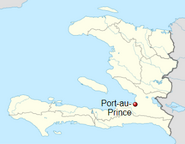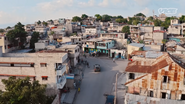
Port-au-Prince is the capital and most populous city of Haiti, situated on the Gulf of Gonave in the Caribbean Sea. In 1503, the Spanish explorer Nicolas Ovando founded the city of Santa Maria de la Paz Verdadera near present-day Port-au-Prince, but it was abandoned several years later; Ovando then founded Santa Maria del Puerto at the same site, but it was burned by French explorers in 1535 and by the English in 1592. In 1606, the Spanish decided to abandon the region, and the region began to be used as a base for buccaneers and Dutch leather merchants. A settlement known as Hôpital was founded on the site, as it was home to a hospital for buccaneers, and, after the Spanish failed to recapture the settlement, they renounced any claims to Hôpital in 1697 at the end of the War of the Grand Alliance. The French began to settle in the area, building colonies at Ester (Petite Riviere) and Gonaives, and in 1706, a French captain, Saint-Andre, arrived in the area aboard the ship La Prince and named the area Port-au-Prince. It was first incorporated in 1749, and in 1770, Port-au-Prince replaced Cap-Francais (Cap-Haitien) as capital of the colony of Saint-Domingue. In November 1791, during the Haitian Revolution, Port-au-Prince was burned during a battle between black Haitian revolutionaries and defending white plantation owners. The British Army captured the city on 4 June 1794 amid the French Revolutionary Wars, but the British were later evicted from the island by Toussaint L'ouverture. In 1804, Port-au-Prince became capital of a newly-independent Haiti. Two battles were fought in the city between the US Marine Corps (aided by Haitian gendarmes) and the rebellious Cacos, in 1919 and 1920, during the United States occupation of Haiti, one of the Banana Wars fought in the region by the US government. Port-au-Prince was again devastated on 12 January 2010, this time by an earthquake. By 2015, Port-au-Prince had a population of 987,310 people, with the majority being Black residents, and biracial people (who controlled the majority of the city's businesses), Hispanics, Asians, Europeans, and Arabs making up significant minorities. Port-au-Prince was once a major destination for cruise ships, but political unrest and high crime drove away all of the cruise lines; by 2012, Port-au-Prince had a murder rate of 60.9 murders per 100,000 residents (it had previously been 219 per 100,000 residents in 2004), with crime being concentrated in the Croix-des-Bouquets, Cite Soleil, Carrefour, Bel Air, Martissant, Boulevard La Saline, Urban Route Nationale 1, and Boulevard Toussaint-Louverture areas.



